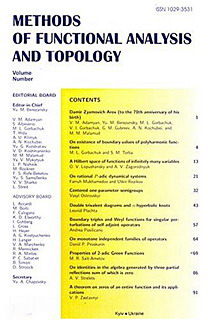E. Tsekanovskii
Search this author in Google Scholar
Conservative L-systems and the Livšic function
S. Belyi, K. A. Makarov, E. Tsekanovskiĭ
MFAT 21 (2015), no. 2, 104-133
104-133
We study the connection between the classes of (i) Livsic functions $s(z),$ i.e., the characteristic functions of densely defined symmetric operators $\dot A$ with deficiency indices $(1, 1)$; (ii) the characteristic functions $S(z)$ of a maximal dissipative extension $T$ of $\dot A,$ i.e., the Mobius transform of $s(z)$ determined by the von Neumann parameter $\kappa$ of the extension relative to an appropriate basis in the deficiency subspaces; and (iii) the transfer functions $W_\Theta(z)$ of a conservative L-system $\Theta$ with the main operator $T$. It is shown that under a natural hypothesis {the functions $S(z)$ and $W_\Theta(z)$ are reciprocal to each other. In particular, $W_\Theta(z)=\frac{1}{S(z)}=-\frac{1}{s(z)}$ whenever $\kappa=0$. It is established that the impedance function of a conservative L-system with the main operator $T$ belongs to the Donoghue class if and only if the von Neumann parameter vanishes ($\kappa=0$). Moreover, we introduce the generalized Donoghue class and obtain the criteria for an impedance function to belong to this class. We also obtain the representation of a function from this class via the Weyl-Titchmarsh function. All results are illustrated by a number of examples.
Sectorial classes of inverse Stieltjes functions and L-systems
MFAT 18 (2012), no. 3, 201-213
201-213
We introduce sectorial classes of inverse Stieltjes functions actingon a finite-dimensional Hilbert space as well as scalar classes ofinverse Stieltjes functions based upon their limit behavior at minusinfinity and at zero. It is shown that a function from theseclasses can be realized as the impedance function of a singularL-system and the operator $\tilde A$ in a rigged Hilbert spaceassociated with the realizing system is sectorial. Moreover, it isestablished that the knowledge of the limit values of the scalarimpedance function allows to find an angle of sectoriality of theoperator $\tilde A$ as well as the exact angle of sectoriality of theaccretive main operator $T$ of such a system. The corresponding newformulas connecting the limit values of the impedance function andthe angle of sectoriality of $\tilde A$ are provided. Application ofthese formulas yields that the exact angle of sectoriality ofoperators $\tilde A$ and $T$ is the same if and only if the limitvalue at zero of the corresponding impedance function (along thenegative $x$-axis) is equal to zero. Examples of the realizingL-systems based upon the Schrodinger operator on half-line arepresented.
On $\mu$-scale invariant operators
K. A. Makarov, E. Tsekanovskii
MFAT 13 (2007), no. 2, 181-186
181-186
We introduce the concept of a $\mu$-scale invariant operator with respect to a unitary transformation in a separable complex Hilbert space. We show that if a nonnegative densely defined symmetric operator is $\mu$-scale invariant for some $\mu>0$, then both the Friedrichs and the Krein-von Neumann extensions of this operator are also $\mu$-scale invariant.
Some remarks on singular perturbations of self-adjoint operators
Yu. M. Arlinskiĭ, E. R. Tsekanovskiĭ
MFAT 9 (2003), no. 4, 287-308
287-308

